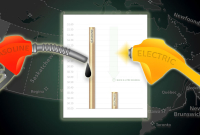Support strong Canadian climate journalism for 2025
In 2080, after 60 years of status quo emissions, Edmonton will be as hot and dry in the summer as Kansas is now, Regina will feel like a much warmer city in South Dakota, and Toronto will be as hot year-round as present-day northern Arkansas.
Future Urban Climates, a new web app, offers users an experience like time travel: the opportunity to liken the future climate of their hometown to the current climate of another city in the world. According to the app, Toronto in 2080 will feel like present-day Gassville, Arkansas, which is known for summers hotter and muggier than Toronto’s, and winters that are colder and wetter.
Matt Fitzpatrick, professor and associate director for research at the University of Maryland Center for Environmental Science, developed the app to help users understand, through real-world comparison, what individual urban climates could look like if humanity doesn’t get its emissions under control.
“By showing people where they would need to go today to experience what their hometown is expected to be like at the end of the century, [we can] communicate the magnitude and the impacts of climate change that we're expecting in the future,” Fitzpatrick said to Canada’s National Observer.
This week in Gassville, temperatures will reach an average high of 35 C. By contrast, Toronto’s average temperature this week will be 26. Gassville is set to see full sun with some cloud coverage, while Toronto is expecting a mixture of sun, cloud and rain.
According to Future Urban Climates, by 2080, Montréal will warm by a year-round average of 7 degrees to match the current climate of Salem, Kentucky. Whitehorse will experience a climate like present day Navajo, New Mexico’s. Victoria will feel as hot and dry in the summer as Three Rivers, California, and Halifax will be almost 20 per cent wetter in the winter — like Rockwood, Tennessee is, now. That is, unless immediate climate action is taken.

Fitzpatrick began working on the app 10 years ago. An ecologist, Fitzpatrick focuses on climate impacts for certain species of birds and trees, and wondered if there was a way to convey urban human impacts to the public. He launched an early version in 2019, which featured around 540 cities, mostly in the U.S. — but the limited reach didn’t convey the magnitude of a changing global climate, so he doubled down.
After learning to code and plugging away at the app for years with no external funding, Fitzpatrick has released the current version, which includes analyses of more than 5,000 cities around the globe.
The app uses multiple climate simulation models to predict future urban climates. However, different climate forecast models make varying assumptions about how climate and weather work, Fitzpatrick noted. This means a range of potential climate futures exist for a given urban area.
Future Urban Climates works by generating the average of five climate simulation models similar to the Canadian Centre for Climate Modelling and Analysis, and presenting “the middle of the road of all the variability” as the best match, explained Fitzpatrick.
The app also accounts for the possibility that we collectively reduce global greenhouse gas emissions.
Users can toggle between two modes — “high” and “reduced” emissions — to see the difference in impact between immediate climate action and inaction. “High emissions” mode suggests analog climates based on our current emissions trajectory, while “reduced emissions” mode adjusts results to match the emissions goals of the Paris Climate Accord.
The IPCC and other environmental bodies have created different emissions pathways based on various possible economic and demographic scenarios. These pathways represent how human decisions factor into potential future climates, said Fitzpatrick. They also inform the “reduced emissions” toggle.
In “reduced” mode, Future Urban Climates predicts that Toronto will be more like Seven Hills, Ohio than Gassville — which means about 4 C cooler year-round, 9 per cent less dry in summer, and 12 per cent less wet in winter than the current emissions trajectory estimate.
“We hear a lot about scientists being alarmist,” said Fitzpatrick. “This is a way to truly articulate why we're so concerned.”
Fitzpatrick hopes Future Urban Climates is as impactful a tool for politicians and city planners as it is for the public in driving home the global transformations continued emissions will cause.
“Success is a lot of people seeing this,” he said. “And maybe that changes enough minds in enough places that we [all] start making changes.”






Comments